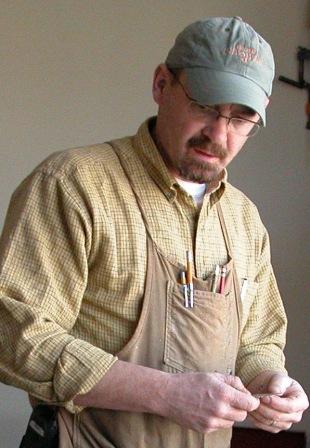
With the two rails of the headboard complete I also needed make the stiles, which also held the leather panels. This connection requires little strength so a lap joint is sufficient. I milled these up on the table saw. A rabbit in each rail and a rabbit in the stiles will hold the leather panel. The rabbit in the rails also holds the stile.
Once these tasks were complete the first glue-up was ready. It is important to make certain everything fits before glue-up. The process must go quickly and smoothly. Prepare everything and prepare for cleanup. No matter how carefully you spread the glue there will be a little squeezed out - especially on a mortise and tenon joint. A little bit a tape along the joint can prevent most of the squeeze-out from getting on the wood thus making clean-up easier and more effective.
In the previous post I briefly discussed wood movement. The bottom tenon was almost 10" long. To accommodate the wood movement I only applied glue to a little more than half of the top of the tenon. This will allow the wood to move downward. Also the tenon should be cut somewhat smaller across the width so as to allow for this movement.
After gluing up the rails and posts I set them aside and milled up the top from 3/4 and 5/4 oak. I then glued the two together and set them aside for the next day. The next day I joined their common edge and connected the top to the rails using biscuits.

Next the leather panels - the leather must be glued to something very smooth as any defect in the surface behind the leather will show on the face of the leather. I used smooth birch plywood, but I wanted the back of the headboard to all be oak too and the panels were not going to be covered. I milled up 1/4 oak and applied it to the back of the plywood creating what amounted to an oak panel. I used Titebond and spread the glue evenly with a tile trowel and then clamped all of the panels up in a large stack.
I didn't want to apply the leather until the wood color was applied and there was one coat of polyurethane on everything, so as to not discolor the leather. Again, I used water-based aniline stain. Tammi's the color expert and always helps me mix the colors and she matched the nightstands exactly. Because aniline stain is water-based it raises the grain so the wood must be hand sanded one final time.
Because aniline stain is water-based it raises the grain so the wood must be hand sanded one final time.
I finished the headboard with a mixture of linseed oil, polyurethane, and thinner. I gradually increased the mix so that the last several coats were only polyurethane. This gives the finish a very deep and lusterious look.
With the panels finished it was time to apply the leather. Previously, I applied a small piece of leather to the birch plywood with regular wood glue (Titebond III) and everything appeared fine. The drying glue didn't bunch the leather and the connection was very strong. Also, I precut leather panels somewhat larger than needed intending to trim it tightly and neatly when the glue dried. I applied leather conditioner to the finished side of the  leather, faced the finish sides to one another, and stacked and pressed the leather flat for a day or so. I didn't want, or need much glue on the panel to hold the leather; however, I did need a nice consistent application so I used a foam roller to spread the glue. This gave the surface a nice even spread. The leather, once fixed, was rolled out with a rolling pin, stacked, and clamped. Once set I trimmed the edges flush and set the panels in the rabbits designed to receive them. I trimmed out the interface of the panel and rabbit with quartersawn 5/16" x 1-3/8" oak strips.
leather, faced the finish sides to one another, and stacked and pressed the leather flat for a day or so. I didn't want, or need much glue on the panel to hold the leather; however, I did need a nice consistent application so I used a foam roller to spread the glue. This gave the surface a nice even spread. The leather, once fixed, was rolled out with a rolling pin, stacked, and clamped. Once set I trimmed the edges flush and set the panels in the rabbits designed to receive them. I trimmed out the interface of the panel and rabbit with quartersawn 5/16" x 1-3/8" oak strips.
I was very happy with the results and I fully expect to incorporate wood and leather together in the future.This is the king size headboard which is just over 6 foot long. 

Thursday, October 30, 2008
Shop - oak and leather headboard- post two
Posted by
Art
at
4:41 PM
![]()
Subscribe to:
Post Comments (Atom)
Leave A Comment
Hey! Leave a comment - good, bad, short, long, whatever. I'd like to hear from you.




No comments:
Post a Comment